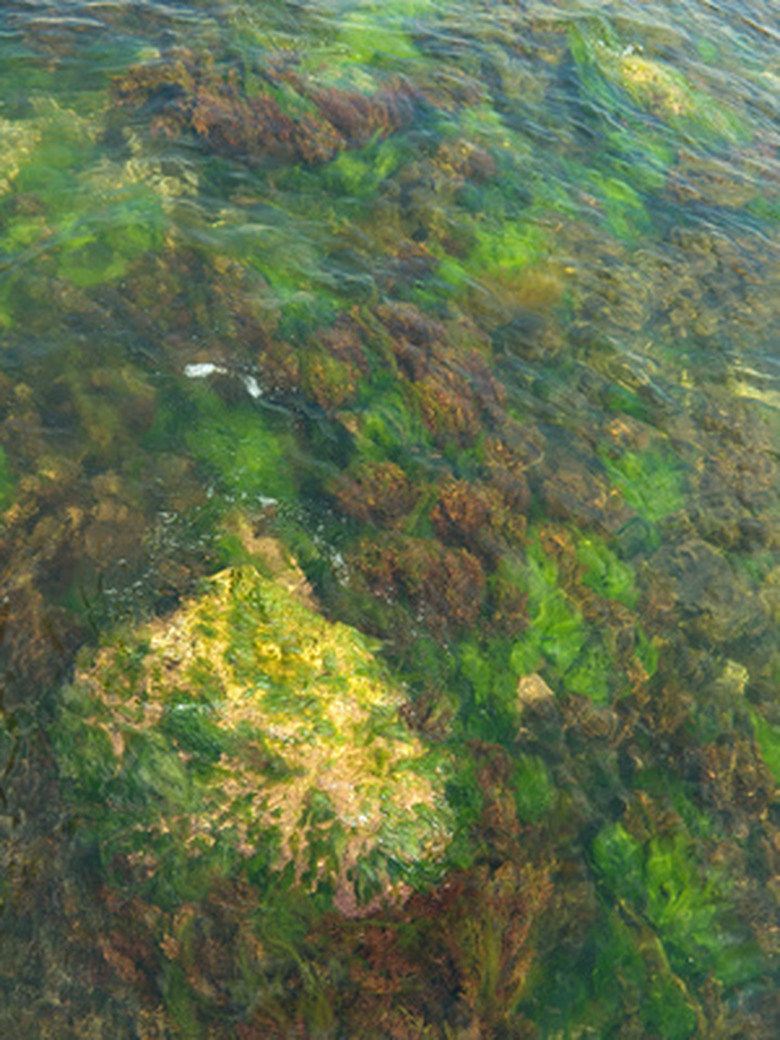The Differences Between Bacteria & Algae
Bacteria and algae are both microorganisms. Many of them are single-celled creatures that feed themselves through photosynthesis. Both algae and bacteria are essential parts of the food chain. Algae makes up the basis of most marine food chains, fueling the ecosystem. Bacteria helps to break down dead organic matter so that it can become part of the soil. Algae is eaten in many Eastern countries as seaweed.
Photosynthesis
Photosynthesis
Algae and some bacteria photosynthesize to create energy just like plants. Photosynthesis is when a life form uses sunlight and converts it into nutrients. However, there are differences in how they do it. Algae stores photosynthesis pigments inside cases called chloroplasts. Not all of algae's chloroplasts have chlorophyll. There are many different chemicals used for photosynthesis, which is why algae comes in so many colors. Bacteria don't have chloroplasts. They can photosynthesize from anywhere on their bodies because their pigments are free floating within the cellular membrane or 'skin' of the bacteria.
Environment
Environment
Algae are found exclusively in marine environments. Found in ponds, pools, lakes and aquariums algae grows only in water. Large species of algae found in the ocean resemble plants, serve as the basis of the ecosystem and are served in Oriental food dishes. Bacteria are found everywhere. They can survive and thrive in water, on skin, surfaces, carpet, earth, stone and especially dead flesh. Bacteria are a life form largely responsible for the decomposition of the dead. Some forms of bacteria are very harmful if they enter your body, which is why many people regularly use antibacterial cleaners and soaps.
Size
Size
All bacteria are single celled. There are small bacteria and large bacteria but the difference between these is individual cell size. They are all still single-celled organisms. Though they occur in extremely large numbers because they reproduce very quickly, one life form consists of one cell. Algae are different in the fact that a single life form of algae may be made up of multiple cells and able to grow dozens of feet long. Bacteria can multiply and cover extremely large areas but they cannot grow.
Reproduction
Reproduction
Both bacteria and algae reproduce asexually; sometimes both of these microbes reproduce sexually. However there is a difference in their methods of asexual reproduction. Bacteria reproduce through single-cell division. This means that a little copy of a bacterium grows within the cell and then divides into a separate cell. Algae can produce many copies at once through reproduction with spores. Small pieces of the algae plant containing its DNA fill an area inside the algae body. They pile up until eventually the skin bursts and the spores are released from the original algae body, forming many copies of the algae cell.
Cite This Article
MLA
Erickson, Michaelyn. "The Differences Between Bacteria & Algae" sciencing.com, https://www.sciencing.com/differences-between-bacteria-algae-7803838/. 24 April 2017.
APA
Erickson, Michaelyn. (2017, April 24). The Differences Between Bacteria & Algae. sciencing.com. Retrieved from https://www.sciencing.com/differences-between-bacteria-algae-7803838/
Chicago
Erickson, Michaelyn. The Differences Between Bacteria & Algae last modified March 24, 2022. https://www.sciencing.com/differences-between-bacteria-algae-7803838/
